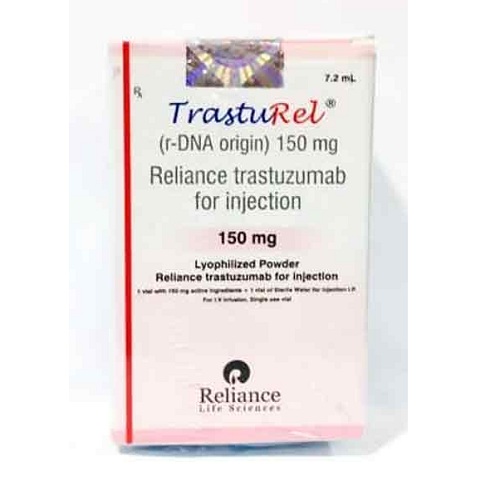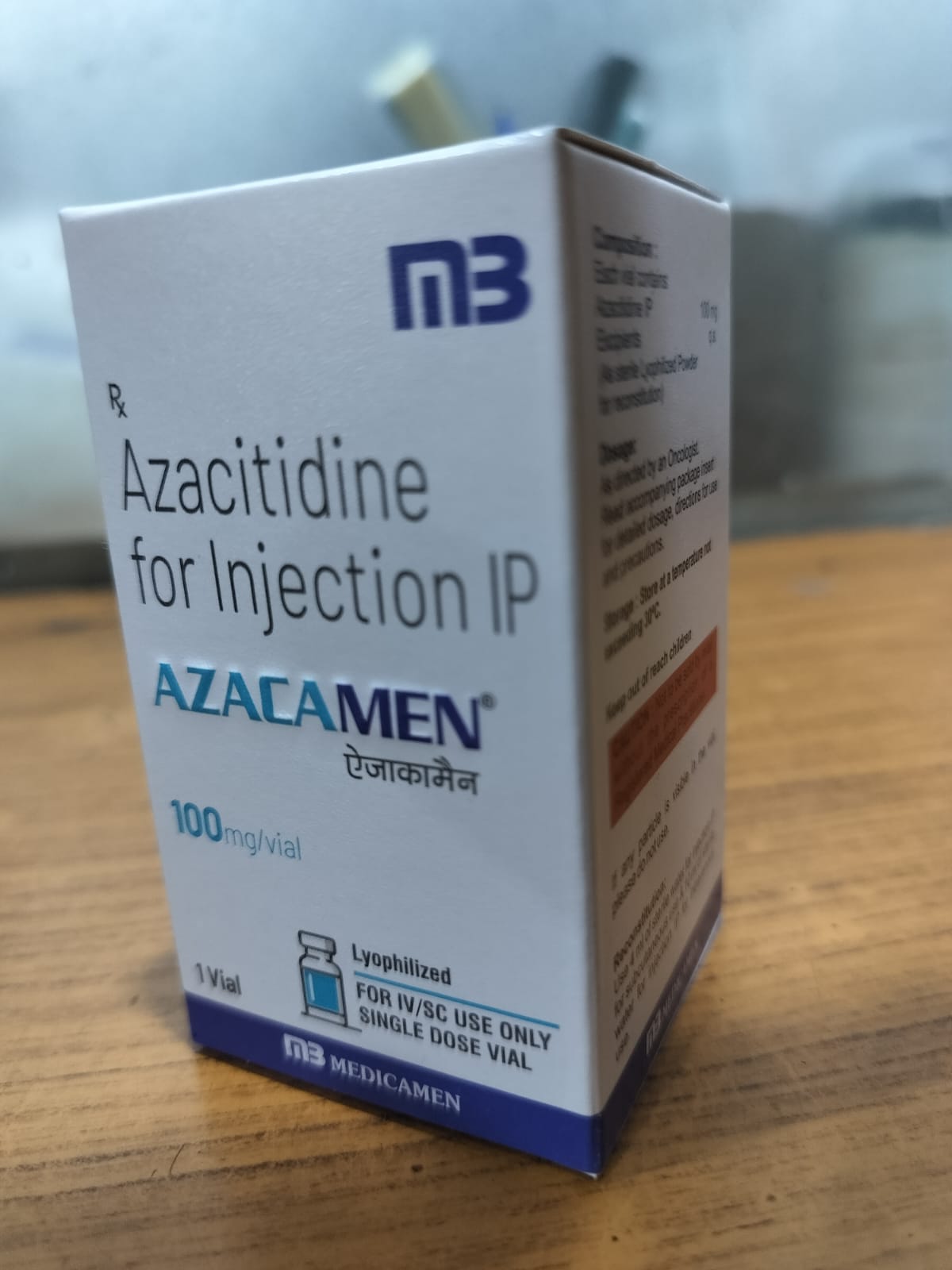Product Introduction:
Trasturel is a biosimilar of Trastuzumab, developed by Reliance Life Sciences. It is used in patients with HER2-positive malignancies, particularly breast and gastric cancers, either alone or in combination with chemotherapy. It is provided as a lyophilized powder that is reconstituted for intravenous infusion.
Uses (Indications):
Trasturel is used in the treatment of:
-
HER2-positive metastatic breast cancer (MBC) – in combination with paclitaxel or as monotherapy
-
Adjuvant treatment of HER2-positive early breast cancer – following surgery, chemotherapy, and/or radiotherapy
-
HER2-positive metastatic gastric cancer – in combination with cisplatin and capecitabine or 5-FU
-
Locally advanced or inflammatory HER2-positive breast cancer
-
Neoadjuvant therapy in early HER2-positive breast cancer
-
Maintenance therapy following initial chemotherapy response in HER2-positive cancers
Storage Instructions:
-
Store the lyophilized powder at 2–8°C (refrigerated)
-
Do not freeze the vial or the reconstituted solution
-
Reconstituted solution should be used within 24 hours if stored under refrigeration
-
Protect from light and contamination
-
Store out of reach of children
How It Works (Mechanism of Action):
Trastuzumab is a humanized monoclonal antibody that selectively binds to the extracellular domain of the HER2 receptor, a transmembrane tyrosine kinase receptor that is overexpressed in 20–30% of breast cancers and some gastric cancers.
Mechanisms include:
-
Inhibition of HER2 signaling → prevents proliferation of cancer cells
-
Antibody-dependent cellular cytotoxicity (ADCC) → enhances immune-mediated destruction of tumor cells
-
Receptor downregulation and apoptosis induction
-
Inhibits angiogenesis and tumor metastasis
Side Effects:
Common Side Effects:
-
Fever and chills (infusion-related reactions)
-
Nausea and vomiting
-
Diarrhea
-
Headache
-
Weakness and fatigue
-
Skin rash
Serious Side Effects:
-
Cardiotoxicity – including congestive heart failure, especially in combination with anthracyclines
-
Infusion reactions – can include hypotension, dyspnea, bronchospasm
-
Pulmonary toxicity – interstitial pneumonitis or pulmonary fibrosis
-
Hematologic toxicity – neutropenia, anemia
-
Hepatotoxicity – elevated liver enzymes
-
Fetal harm – contraindicated in pregnancy due to potential embryo-fetal toxicity
Dosage (Typical Recommended Dose):
For Breast Cancer:
-
Loading dose: 8 mg/kg IV infusion over 90 minutes
-
Maintenance dose: 6 mg/kg IV every 3 weeks over 30–90 minutes
For Gastric Cancer:
-
Loading dose: 8 mg/kg IV infusion over 90 minutes
-
Maintenance dose: 6 mg/kg IV every 3 weeks
Doses are adjusted based on weight and clinical response, and cardiac function must be assessed regularly.
Method of Administration:
-
IV infusion only, not for IV push or bolus
-
Reconstitute lyophilized powder with sterile water as per instructions
-
Administer through infusion pump under close monitoring
-
First infusion should be given over 90 minutes; subsequent doses may be shortened if tolerated
-
Pre-medication (antipyretics, antihistamines) may be given to reduce infusion reactions
Precautions:
-
Cardiac monitoring before and during therapy is mandatory (e.g., LVEF assessments every 3 months)
-
Use with caution in patients with pre-existing heart disease or prior anthracycline therapy
-
Pregnancy must be avoided – contraception required during and 7 months after treatment
-
Discontinue in case of severe infusion reactions or pulmonary toxicity
-
Monitor CBC, liver enzymes, and renal function regularly
-
Do not substitute biosimilars interchangeably without oncologist approval
Drug Interactions:
-
Anthracyclines (e.g., Doxorubicin) – increased risk of cardiac toxicity
-
Cyclophosphamide – may potentiate myelosuppression
-
Radiotherapy – increased pulmonary and cardiac risks
-
Paclitaxel/Docetaxel – commonly co-administered but may enhance neutropenia
-
No significant CYP450 interactions; however, caution advised in polypharmacy scenarios
Allergies (Warnings for Allergic Reactions):
-
Contraindicated in patients with known hypersensitivity to Trastuzumab or any excipients
-
Infusion-related reactions may involve urticaria, angioedema, and bronchospasm
-
Anaphylaxis has been reported – resuscitation equipment should be readily available during administration
-
Premedicate high-risk patients with antihistamines and corticosteroids
Overdose Information:
-
Limited data available on Trastuzumab overdose
-
Symptoms may include severe infusion reaction, cardiac dysfunction, and respiratory distress
-
Provide symptomatic and supportive care
-
Monitor vitals and cardiac function intensively
-
No specific antidote available
Missed Dose Instructions:
-
If a scheduled dose is missed by less than 1 week, administer as soon as possible
-
If delayed by more than 1 week, re-administer the loading dose (8 mg/kg)
-
Resume the regular schedule afterward
-
Doses should always be administered under supervision of an oncology professional
Additional Notes:
-
HER2 testing (IHC or FISH) must confirm HER2 positivity before initiating Trastuzumab
-
Not interchangeable with subcutaneous formulations without dosage adjustment
-
Patients should be educated about early symptoms of heart failure or allergic reactions
-
Periodic echocardiography or MUGA scan is standard during treatment
-
Combination with chemotherapy should follow established oncological protocols
-
Trasturel is a cost-effective biosimilar option compared to the innovator (Herceptin) in many countries



